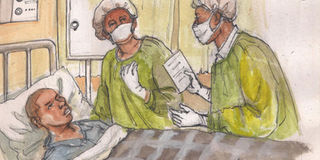Understanding manslaughter

When a person is deemed to have been responsible for the death of another as a result of some unlawful action, they may be charged with murder or manslaughter.
The charge of murder will succeed in court if the accused is shown to have planned and intentionally killed his victim. Manslaughter, is defined as causing the death of another person by an unlawful act or omission unintentionally or without planning.
In such a case the offender did not form the intention to kill, or the killing was not willful or deliberate. An unlawful omission is negligence to discharge a duty tending to the preservation of life or health.
Manslaughter in such jurisdictions differs from murder in one main aspect, the offender did not act with malice aforethought. However, some jurisdictions may try a case regarded as manslaughter in another jurisdiction as second degree murder.
Voluntary and involuntary
Manslaughter may be of two types; voluntary and involuntary manslaughter. Voluntary manslaughter is intentional killing in which the offender had no prior intent to kill. It’s a killing which occurs in the “heat of passion”.
The circumstances leading to the killing must be the kind that would cause a reasonable person to become emotionally or mentally disturbed. It is the killing of a human being without malice.
The term “heat of passion” means an irresistible emotion that an ordinary reasonable person would experience under the same facts and circumstances.
Voluntary manslaughter may also occur when a killer has a mistaken belief that the killing is justified in such cases of self defence or when the killer honestly but unreasonably believes that a situation requires deadly force.
Involuntary manslaughter means an unintentional killing that results from recklessness or criminal negligence or resulting from an unlawful act without criminal intent. It is also called criminally negligent homicide.
The acts here are inherently dangerous to others or done with reckless disregard for human life. And the accused should have known his or her conduct was a threat to the lives of others.
Activities that are entirely legal can also result in involuntary manslaughter when carried out irresponsibly or recklessly. Health workers have been successfully prosecuted under this particular law when deaths have resulted from medical negligence.
Rash or negligent act leading to death
In jurisdictions where involuntary manslaughter is not in the law books, an alternative charge is that of “Rash or negligent act leading to death”.
In one such Penal Code Act, the law states that any person, who by a rash or negligent act not amounting to manslaughter causes the death of another person, commits a crime.
The law further states that any person who, in a manner so rash or negligent, as to endanger human life or to be likely to cause harm to any other person, commits an offence. Examples of rash or negligent actions include giving medical or surgical treatment to any person whom he or she has undertaken to treat. The specific actions include dispensing, supplying or giving any medicine or dangerous substance.
Protective law
There is, however, a law that protects health workers in the course of their practice.
The law states that any person is not criminally responsible for performing in good faith and with reasonable skill a surgical operation upon any person for his or her benefit or upon an unborn child for the preservation of the mother’s life, if the performance of the operation is reasonable and having regard to the patient’s state at that time and to all the circumstances of the case.
This particular aspect of the law has been used to justify the termination of a pregnancy if the pregnancy endangers the life or health of the mother.




